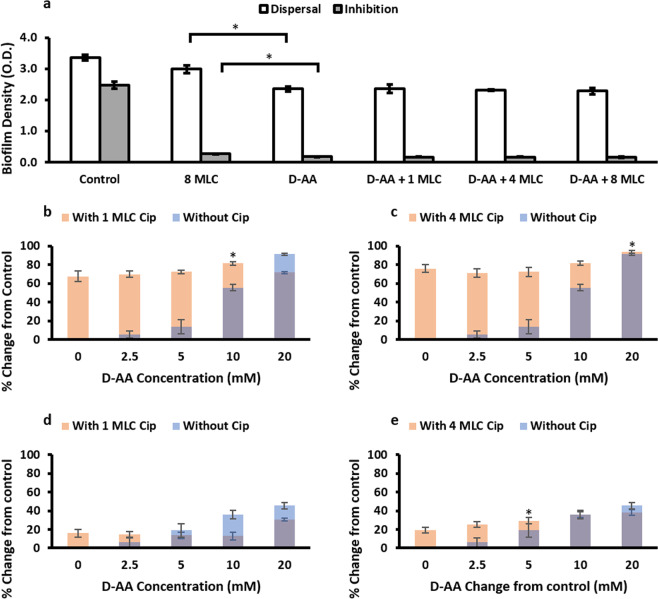Figure 3.
(a) Efficacy of 8 MLC Cip, 40 mM D-AA and 40 mM D-AA combined with 1 MLC, 4 MLC and 8 MLC Cip on biofilm density whilst inhibiting and dispersing S. aureus biofilms. Two tailed T-test revealed that D-AA have a significantly (indicated by *) greater anti-biofilm activity (inhibition p < 0.001, dispersal p < 0.0001) as compared to 8x MLC of Ciprofloxacin. One-way ANOVA showed no significant synergistic effect (p > 0.05) on biofilm density between D-AA and when D-AA and Cip are used in combination. a-e) Synergistic effect of using combination of 1 MLC (b,d) or 4 MLC (c,e) Cip with 2.5, 5, 10 and 20 mM D-AA on biofilm inhibition (b,c) and dispersal (d,e). One-way ANOVA showed an overall significant difference for amino D-AA + Cip data (b-e). This was followed by a post-hoc t-test with Bonferroni correction to see which concentration of D-AA + Cip had significantly higher (p < 0.01) anti-biofilm activity as compared Cip on its own. Next one-tail t test was done to see whether this combination of D-AA + Cip had significantly (p < 0.05) improved anti-biofilm activity as compared to the corresponding D-AA on its own. (b) 10 mM D-AA + 1 MLC Cip was significantly (*) able to inhibit greater biofilm formation compared to both Cip and D-AA on their own (p < 0.001 and p < 0.00001 respectively). (c) 20 mM D-AA + 4 MLC Cip was significantly (*) able to inhibit greater biofilm formation compared to both Cip and D-AA on their own (p = 0.00014 and p = 0.014 respectively). (d) No combination was significantly able to disperse greater biofilm compared to both Cip and D-AA on their own (e) 5 mM D-AA + 4 MLC Cip gave significant (*) rise in biofilm dispersal activity compared to both Cip and D-AA on their own (p = 0.0045 and p = 0.018 respectively). (a-e) D-AA = 40 mM D-Aspartic acid and 40 mM D-Glutamic acid; x MLC = x times minimum lethal concentration; Cip = ciprofloxacin; n = 3, ±S.D.

